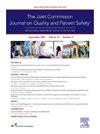回顾导致住院病人自杀的可改变的医疗保健因素:使用医疗保健的人为因素分析和分类系统分析验尸官的报告。
IF 2.3
Q2 HEALTH CARE SCIENCES & SERVICES
Joint Commission journal on quality and patient safety
Pub Date : 2024-05-31
DOI:10.1016/j.jcjq.2024.05.008
引用次数: 0
摘要
背景:住院病人自杀对病人、家属和医疗机构都会造成破坏性的长期后果,这也是医院面临的一大挑战。尽管许多研究已经确定了住院病人自杀的患者风险因素,但对可改变的医疗保健因素了解较少。如果不了解这些可改变的因素,就会削弱医疗机构设计和实施有效预防策略的能力:采用医疗保健人为因素分析和分类系统(HFACS-Healthcare)对2009年至2018年间直接或间接导致澳大利亚医院住院病人自杀的可改变医疗保健因素进行分类和分析。对综合医院和精神病院进行了比较,以确定针对具体情况的建议:在367个案例中,216个案例(58.9%)有足够的信息来分析诱因,其中214个案例(58.3%)包含了单位位置信息。在这些病例中,有多种可改变的医疗因素被认为是导致患者自杀的原因。病例中常见的是个人决策失误(57.4%)、物理环境问题(56.0%)和单位层面的操作决策失误(即计划不当的操作)(48.6%)。研究发现,单位类型与协调问题、精神状态问题、任务问题、物理环境问题、计划不当操作问题和组织文化问题之间存在关联(P < 0.05):结论:一般预防措施可能无法有效解决各专科病房的住院病人自杀问题。通过 HFACS-Healthcare,我们对住院病人自杀有了更深入的了解,并确定了优先领域,如果这些领域得到解决,将有助于减少医院中可预防的自杀人数。医院自杀预防措施需要针对具体科室量身定制,并针对个人和系统的薄弱环节,以提高安全性并降低住院病人自杀率。本文章由计算机程序翻译,如有差异,请以英文原文为准。
A Review of Modifiable Health Care Factors Contributing to Inpatient Suicide: An Analysis of Coroners’ Reports Using the Human Factors Analysis and Classification System for Healthcare
Background
Inpatient suicides have devastating and long-lasting consequences for patients, families, and health care organizations, posing a major challenge for hospitals. Although many studies have identified patient risk factors for inpatient suicide, the modifiable health care factors are less understood. Failure to understand these modifiable factors weakens organizations’ ability to design and implement effective prevention strategies.
Methods
The Human Factors Analysis and Classification System for Healthcare (HFACS–Healthcare) was used to classify and analyze modifiable health care factors that contributed directly or indirectly to inpatient suicides in Australian hospitals between 2009 and 2018. Comparisons were made between general and psychiatric hospital units to identify context-specific recommendations.
Results
Of the 367 cases, 216 (58.9%) had enough information to analyze the contributing factors, and 214 (58.3%) included unit location information. Multiple modifiable health care factors were identified in the cases as contributing to the patients’ suicides. Commonly, cases reported decision errors made by individuals (57.4%), problems with the physical environment (56.0%), and unit-level operational decision-making errors (that is, planned inappropriate operations) (48.6%). An association was found between unit type and problems with coordination, mental state, tasks, physical environment, planned inappropriate operations, and organizational culture (p < 0.05).
Conclusion
General prevention initiatives may not be effective in addressing inpatient suicides across specialty units. HFACS–Healthcare enabled a deeper understanding of inpatient suicide and the identification of priority areas that, if addressed, could help reduce the number of preventable suicides in hospitals. Hospital suicide prevention initiatives need to be tailored to specific units and target individual and system vulnerabilities to improve safety and reduce inpatient suicide rates.
求助全文
通过发布文献求助,成功后即可免费获取论文全文。
去求助
来源期刊

Joint Commission journal on quality and patient safety
HEALTH CARE SCIENCES & SERVICES-
CiteScore
3.80
自引率
4.30%
发文量
116
审稿时长
49 days
 求助内容:
求助内容: 应助结果提醒方式:
应助结果提醒方式:


